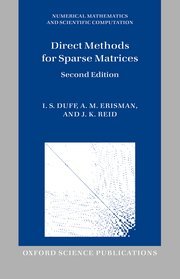Description
Direct Methods for Sparse Matrices (2nd Ed.)
Numerical Mathematics and Scientific Computation Series
Authors: Duff I. S., Erisman A. M., Reid J. K.
Language: English
Subject for Direct Methods for Sparse Matrices:
110.30 €
In Print (Delivery period: 21 days).
Add to cart
Publication date: 01-2017
450 p. · 16.1x23.5 cm · Hardback
450 p. · 16.1x23.5 cm · Hardback
Description
/li>Contents
/li>Biography
/li>
The subject of sparse matrices has its root in such diverse fields as management science, power systems analysis, surveying, circuit theory, and structural analysis. Efficient use of sparsity is a key to solving large problems in many fields. This second edition is a complete rewrite of the first edition published 30 years ago. Much has changed since that time. Problems have grown greatly in size and complexity; nearly all examples in the first edition were of order less than 5,000 in the first edition, and are often more than a million in the second edition. Computer architectures are now much more complex, requiring new ways of adapting algorithms to parallel environments with memory hierarchies. Because the area is such an important one to all of computational science and engineering, a huge amount of research has been done in the last 30 years, some of it by the authors themselves. This new research is integrated into the text with a clear explanation of the underlying mathematics and algorithms. New research that is described includes new techniques for scaling and error control, new orderings, new combinatorial techniques for partitioning both symmetric and unsymmetric problems, and a detailed description of the multifrontal approach to solving systems that was pioneered by the research of the authors and colleagues. This includes a discussion of techniques for exploiting parallel architectures and new work for indefinite and unsymmetric systems.
- 1: Introduction
- 2: Sparse matrices: storage schemes and simple operations
- 3: Gaussian elimination for dense matrices: the algebraic problem
- 4: Gaussian elimination for dense matrices: numerical considerations
- 5: Gaussian elimination for sparse matrices: an introduction
- 6: Reduction to block triangular form
- 7: Local pivotal strategies for sparse matrices
- 8: Ordering sparse matrices for band solution
- 9: Orderings based on dissection
- 10: Implementing Gaussian elimination without symbolic factorize
- 11: Implementing Gaussian elimination with symbolic factorize
- 12: Gaussian elimination using trees
- 13: Graphs for symmetric and unsymmetric matrices
- 14: The SOLVE phase
- 15: Other sparsity-oriented issues
- A: Matrix and vector norms
- B: Pictures of sparse matrices
- C: Solutions to selected exercises
- 2: Sparse matrices: storage schemes and simple operations
- 3: Gaussian elimination for dense matrices: the algebraic problem
- 4: Gaussian elimination for dense matrices: numerical considerations
- 5: Gaussian elimination for sparse matrices: an introduction
- 6: Reduction to block triangular form
- 7: Local pivotal strategies for sparse matrices
- 8: Ordering sparse matrices for band solution
- 9: Orderings based on dissection
- 10: Implementing Gaussian elimination without symbolic factorize
- 11: Implementing Gaussian elimination with symbolic factorize
- 12: Gaussian elimination using trees
- 13: Graphs for symmetric and unsymmetric matrices
- 14: The SOLVE phase
- 15: Other sparsity-oriented issues
- A: Matrix and vector norms
- B: Pictures of sparse matrices
- C: Solutions to selected exercises
I. S. (Iain) Duff is an STFC Senior Fellow in the Scientific Computing Department at the STFC Rutherford Appleton Laboratory in Oxfordshire, England. He is also the Scientific Advisor for the Parallel Algorithms Group at CERFACS in Toulouse and is a Visiting Professor of Mathematics at the University of Strathclyde. J. K. (John) Reid is an Honorary Scientist at the STFC Rutherford Appleton Laboratory in Oxfordshire, England. He is also a Visiting Professor at the Shrivenham Campus of Cranfield University and is Convener of the ISO/IEC Fortran Committee. A. M. (Al) Erisman is the Executive in Residence in the School of Business, Government, and Economics at Seattle Pacific University and is executive editor of Ethix magazine (
© 2024 LAVOISIER S.A.S.

